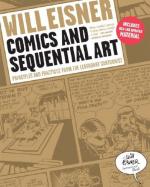
|
| Name: _________________________ | Period: ___________________ |
This test consists of 15 multiple choice questions and 5 short answer questions.
Multiple Choice Questions
1. What do the writer and artist "pledge allegiance" to when working on comics together?
(a) A specific skill set.
(b) The integrated whole.
(c) The point.
(d) The message.
2. What kind of printing never became widespread in comic printing.
(a) Photogravure printing.
(b) Lineogravure printing.
(c) Rotogravure printing.
(d) Blaugravure printing.
3. What field is writing for comics closely related to?
(a) Linguistics.
(b) Playwriting.
(c) Theatrics.
(d) Journalism.
4. In theory, what does the reader/viewer already know how to understand?
(a) Philosophical principles.
(b) Sequential art.
(c) Linear algebra.
(d) Parallel dimensions.
5. Who is the artist at the mercy of?
(a) The commentator's shop.
(b) The engraver's shop.
(c) The copywriter's shop.
(d) The publisher's shop.
6. What kind of stories have dominated the field of comics because of the limitations of the medium?
(a) Didactic moral stories.
(b) Simple, obvious stories.
(c) Life-changing stories.
(d) Complex, intriguing stories.
7. How big is the simplified script when determining an agreement between artist and writer?
(a) Sixty inches.
(b) Half a page.
(c) Two pages.
(d) Twenty pages.
8. What dominates the reader's initial response?
(a) Texture.
(b) Artwork.
(c) Text.
(d) Hardbound novels.
9. What is the most useful and most used word in comics?
(a) Meanwhile.
(b) Now.
(c) During.
(d) Consequently.
10. What does Eisner use as an example to stress the value and dignity of work and whet interest and curiosity?
(a) Bookends.
(b) Manuscripts.
(c) Career booklets.
(d) Pamphlets.
11. What gives voice to thoughts and gives meaning to action?
(a) Analog.
(b) Monologue.
(c) Dialog.
(d) Soliloquy.
12. What can artists be tempted to do to detract from the storyline?
(a) Sharpen the mind.
(b) Dazzle the eye.
(c) Seize the day.
(d) Hone the craft.
13. What do most humans understand the face as?
(a) A window to the heart.
(b) A window to the mind.
(c) A window to the eyes.
(d) A pathway to the top.
14. What kind of comics are generally entertainment-oriented?
(a) Stickers and graphic novels.
(b) Comic books and warning labels.
(c) Fairy tales and dailies.
(d) Periodical comics and graphic novels.
15. What was the name of Eisner's 1981 attempt to illustrate Shakespeare's famous soliloquy of Hamlet?
(a) Hamlet in the Kitchen.
(b) Hamlet in the Valley.
(c) Hamlet on a Rooftop.
(d) Hamlet on a Mountaintop.
Short Answer Questions
1. What is the absolute ratio of words to picture in comics?
2. What does reading provide for the artist that he or she can use?
3. What does Chapter 5 examine?
4. What other method requires production of a paperboard with colors added to transparent overlays?
5. How many points does Eisner say an artist must understand about how objects work?
|
This section contains 420 words (approx. 2 pages at 300 words per page) |

|




